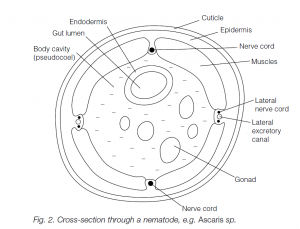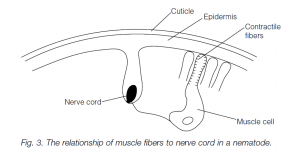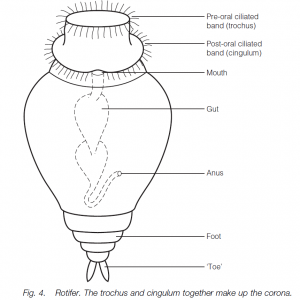Classification: Kingdom Animalia, Sub-Kingdom Metazoa, Phylum Nematoda, Common Names: roundworms, threadworms
▶Features
- Type of organism
There are about 80 000 species of nematode described, although this is probably an underestimate. Sizes range in length from 100 ìm to more than 100 cm. Nematodes are usually long, cylindrical ‘worms’ (Fig. 1) with tapered, rounded ends, although some parasitic forms are sac-like in shape. Cilia (except in sense organs) are absent. Many nematodes are parasites in animals and plants. Trichinella spiralis causes trichinosis in humans, acquired from eating inadequately cooked pork. Larvae of the nematode encyst in striped (striated) muscle; when this is eaten, the cysts are digested, freeing the larvae into the new host’s gut. After about 2 days, the nematodes are sexually mature and males and females mate. The females burrow into the intestinal lining and release enormous numbers of larvae (the females are ovoviviparous). The larvae reach the bloodstream having first entered the lymph. From the blood they burrow into muscles and encyst.
Ascaris lumbricoides is a parasite of pigs and humans; the adult lives in the intestine. Eggs are shed in feces and then develop in the soil; re-infection occurs through the ingestion of eggs containing embryos. These hatch in the intestine of the new host and burrow into the wall of the bowel. The larvae enter the lymphatic and then the blood system and pass through the heart to the lungs. From here, they break through to the lung alveoli and thence pass up the bronchioles to the trachea, and then down the esophagus to re-establish themselves in the alimentary tract. Larvae within the lungs can lead to pneumonia; adult nematodes in the bowel can produce neurotoxins and well as causing physical blockages. Free-living nematodes inhabit aquatic and moist terrestrial habitats; they are important in the ecosystem for cycling of minerals and food components and for aerating the soil.

- Body plan
Nematodes are bilaterally symmetrical, triploblastic animals which are covered by a tough, elastic cuticle. Segmentation is not present. The epidermis surrounds longitudinal muscles which in turn surround the body cavity which is a pseudocoel.


- Feeding
The pseudocoel surrounds the long straight ‘complete’ gut which is lined with endoderm. The gut may have specialized mouth parts such as elaborate, predatory teeth, or hooks to attach the worm to its host.
- Locomotion
The absence of circular muscles means that nematodes move by contracting their longitudinal muscles to flex the body in anguilliform (eel-like) waves.
- Skeleton
The muscles act against the turgor of the pseudocoel which serves as a hydrostatic skeleton whose constant volume is contained by the thick, tough cuticle.
- Respiratory and vascular system
Nematodes do not have respiratory organs: gas exchange occurs through the integument. There is no blood vascular system.
- Osmoregulation and excretion
The excretory system consists of two lateral, longitudinal canals which open by a pore near the anterior end of the worm.
- Co-ordination
The nervous system comprises a circumpharyngeal commissure (a ring around the pharynx) and longitudinal nerve cords passing along the body.
- Reproduction
The sexes are separate, with the male usually being smaller than the female of the species. Fertilization, during which the male may grasp the female with copulatory spicules, is internal. The gonads (with paired or single ovaries or testes) have ducts which exit through a female gonopore, or via the cloaca in the male. Many millions of eggs are produced. These may be very hardy and desiccation resistant. An example is Ascaris lumbricoides
▶Related phyla Phylum Rotifera (Common name: wheel animalcules)
There are about 1500 species of rotifers, most of them living in fresh water although a few marine species are known, as well as some which live on damp mosses or in soil; their sizes range from 0.1 mm to 1.0 mm. The body is elongated, with about 1000 cells, often very constant for each species and/or organ: this phenomenon is called eutely. Rotifers have a trunk and a posterior foot. The anterior end bears a corona of cilia, frequently arranged in two disks. The disks beat with circular waves, one clockwise and the other counter clockwise, giving an appearance of wheels. They can swim using these cilia, or crawl in a hirudiform (leech-like) manner using adhesive glands near the forked foot (which can telescope in many species); a few rotifers are sessile and some are planktonic, never settling on the substratum. Water currents created by corona may bring in food particles. The pharynx possesses a mastax with cuticular teeth projecting into the gut lumen. There is a large stomach and a short intestine leading to the anus.
Reproduction can be sexual using internal fertilization. Miniature adults hatch from the limited number of eggs laid (one for each nucleus in the ovary). The males are sexually mature on hatching, the females within a few days. After several generations, dormant thick-skinned eggs, that are resistant to cold and desiccation, are produced prior to winter. Parthenogenesis (‘virginbirth’) is also common and, in some species, no males are known – the parthenogenetic, thin-skinned eggs are diploid and produce only females. In some species, when the rotifer population reaches a certain level, haploid eggs are produced and males may hatch. Fertilized eggs are thick skinned and undergo dormancy. An example is Philodina roseola.

